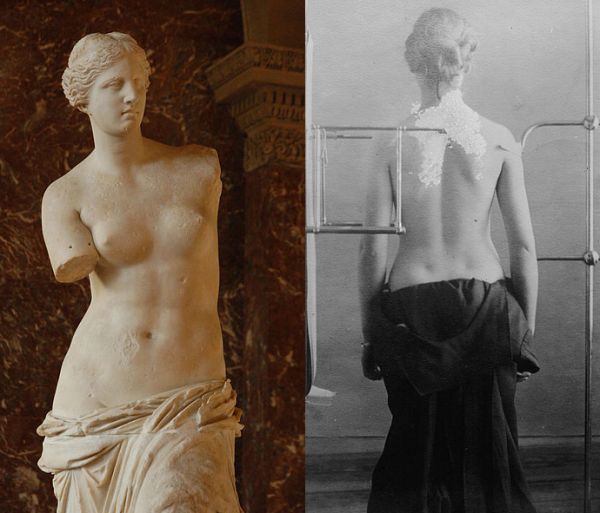 In
1820, a farmer dug up a mysterious Greek statue on the island of Melos.
He found a remarkably well-preserved statue of what is probably
Aphrodite, the Greek goddess of beauty—or Venus, as the Romans called
her. This amazing find became known as the Venus de Milo.
In
1820, a farmer dug up a mysterious Greek statue on the island of Melos.
He found a remarkably well-preserved statue of what is probably
Aphrodite, the Greek goddess of beauty—or Venus, as the Romans called
her. This amazing find became known as the Venus de Milo.She arrived at just the right time. The Academic art movement venerated the majesty of the human body, as well as gave men a good excuse to look at pictures of naked women. The Venus de Milo came to epitomize a neoclassical vision of female beauty.
In the United States, the idealization of this beauty standard led to contests in which men searched for women who had Venus’s precise measurements. Thousands of women were measured in this effort, particularly college students, such as this young lady at Wellesley College. Atlas Obscura traces the history of this movement. One leader was Dr. Dudley Allen Sargent, the gym director at Harvard University:
These measurement cards did not require just height, weight, bust, waist, and hips. There were 60 required measurements per person, including instep, wrist, forearm, armspan, and “ninth rib.” And all this data was being put toward new and novel applications. In 1893, Sargent used composite figures from female students' measurements to sculpt a statue and exhibit it at that year's Chicago World's Fair. This figure came to be known as the "Harvard Venus." Visitors to the fair were invited to examine it, reflect on how their own bodies compared, and submit themselves to be measured for Sargent's data collection project. [...]The movement petered out during the 1920s as new beauty standards took hold of American popular culture. It never did find its truly perfect example of the female form, which is reasonable, as my wife would not be born for a few more decades.
By this time, Sargent had collected the measurements of over 10,000 female students, yet he claimed he had still not encountered the ideal woman. “Among the many thousands who have been measured at the gymnasium, not one has fulfilled every requirement,” he told the Times. The closest was Annette Kellerman, an Australian swimmer and vaudeville star who stood five-foot-four-and-a-half and sported a 35.2-inch bust, 26.2-inch waist, and 37.8-inch hips. Sargent called her the "perfect woman" for publicity purposes, but he was rounding up.

No comments:
Post a Comment